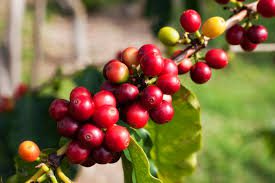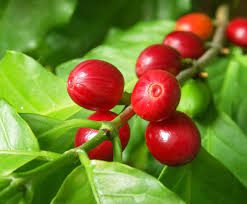Coffee cherries, also known simply as coffee berries, are the fruit of the coffee plant (Coffea genus) that contains the coffee beans. These cherries are small, round or oval-shaped, and typically have a vibrant red color when ripe, although they can also be yellow or other shades depending on the coffee variety.
The outermost layer of the coffee cherry is thin and protective, often referred to as the exocarp or skin. It’s the first part of the cherry that is removed during processing. Beneath the outer skin lies the pulp, which is a thick, juicy layer that surrounds the coffee beans. The pulp is sweet and contains sugars that contribute to the fruit’s flavor.
Inside the coffee cherry, there are usually two coffee beans, each covered by the parchment and silver skin. These beans are the actual seeds of the coffee plant and are what’s harvested and processed to produce coffee.
Coffee cherries undergo various stages of processing to extract the coffee beans, which are then roasted and ground to make coffee. The flavor and characteristics of the coffee can be influenced by the quality and ripeness of the cherries, as well as the processing methods used. The complex interactions between the different layers of the cherry contribute to the wide variety of flavors found in different types of coffee.
The Economic Importance and Uses of Coffee Cherries

Coffee cherries, the fruit of the coffee plant, hold significant economic importance and have various uses beyond just producing coffee beans.
Here are some of the key economic uses and benefits of coffee cherries:
1. Coffee Bean Production: The primary economic importance of coffee cherries lies in their role as the source of coffee beans. The beans are extracted from the cherries and processed to produce the coffee that is enjoyed worldwide. Coffee is one of the most traded commodities globally, making it a crucial driver of economic activity in coffee-producing regions.
2. Coffee Farming and Export: Coffee cultivation is a major economic activity in many countries, particularly in regions with suitable climate and terrain. The cultivation, harvesting, and export of coffee beans contribute significantly to the economies of countries like Brazil, Colombia, Vietnam, Ethiopia, and others. This creates jobs, generates income, and supports rural livelihoods.
3. Food Products: Coffee cherries are not only used for extracting coffee beans but are also utilized in various food products. In some regions, the pulp of the cherries is used to make jams, jellies, sauces, and even alcoholic beverages. These products can provide additional revenue streams for coffee farmers and processors.
4. Coffee Byproducts: The processing of coffee cherries yields byproducts that can have economic value. For instance, the pulp, mucilage, and parchment that are removed during processing can be used as compost, animal feed, or even to produce biofuels. This reduces waste and can offer economic benefits through alternative applications.
5. Health and Nutraceutical Products: Coffee cherries contain compounds with potential health benefits, such as antioxidants and polyphenols. Extracts from coffee cherries are being explored for their potential use in nutraceuticals and dietary supplements. These products can cater to health-conscious consumers and contribute to the growing market for functional foods.
Read Also: Coffee Roots: Economic Importance, Uses and By-Products
6. Beauty and Cosmetics: Extracts from coffee cherries are finding their way into beauty and cosmetics products. The antioxidants and natural compounds in these extracts are believed to have benefits for skin health. As a result, coffee-based skincare products, facial scrubs, and lotions are being developed and marketed, creating a niche market with economic potential.
7. Flavoring and Culinary Uses: The flavor profile of coffee cherries extends beyond just coffee. The cherries have a unique taste that can be used in culinary creations. Chefs and food manufacturers experiment with coffee cherries as an ingredient in various dishes, desserts, and beverages, adding a distinctive flavor and creating marketable gourmet products.
8. Tourism and Agritourism: Coffee farms and plantations often attract tourists interested in experiencing the coffee production process firsthand. This has given rise to the concept of agritourism, where visitors can learn about coffee cultivation, harvesting, and processing. Tourist activities on coffee farms contribute to local economies and diversify revenue sources for farmers.
9. Research and Innovation: Research into coffee cherries’ components and potential uses can lead to innovations that create new markets and economic opportunities. Whether it’s discovering novel compounds with health benefits or developing sustainable agricultural practices, such research can drive economic growth and advancements in the coffee industry.
10. Cultural and Social Significance: In many coffee-producing regions, coffee has cultural and social significance, often being an integral part of traditional ceremonies, social gatherings, and cultural practices. This can lead to the promotion of local heritage and cultural tourism, contributing to the overall economic development of these regions.
The Products and By-products That Can Be Derived From Coffee Cherries

Coffee cherries are the fruits that contain coffee beans, and they can be utilized to create a variety of products and by-products. The coffee cherry typically consists of three main components: the outer skin (exocarp), the pulp (mesocarp), and the parchment (endocarp) that surrounds the coffee bean.
Here are the main products and by-products that can be derived from coffee cherries:
1. Coffee Beans: The coffee beans are the seeds found inside the coffee cherries. These beans can be extracted, processed, and roasted to produce the familiar coffee beverage. Coffee beans are the primary product derived from coffee cherries.
2. Coffee Pulp: The pulp is the fleshy outer layer of the coffee cherry. It contains sugars and organic compounds. It can be used to produce various products:
3. Coffee Pulp Natural: In this process, the cherries are dried with the pulp still intact. This can lead to unique flavors in the coffee due to the fermentation that occurs within the cherry.
4. Coffee Pulp Honey: A method where some of the pulp is left on the beans during drying, creating a range of flavors between natural and washed coffees.
5. Compost and Fertilizer: Coffee pulp can be composted and used as a natural fertilizer, enriching the soil with nutrients.
Read Also: Coffee Silver skin: Economic Importance, Uses and By-Products
6. Coffee Cherry Tea (Cascara): The dried husks of the coffee cherry, known as “cascara,” can be brewed into a tea-like beverage. Cascara has a mild fruity flavor with a hint of coffee undertones and is becoming popular as a drink in its own right.
7. Coffee Liqueur and Extracts: The pulp and cherries can be used to create coffee-flavored liqueurs and extracts, adding a unique coffee fruit flavor to cocktails, desserts, and more.
8. Animal Feed: Coffee pulp can be fed to animals as a nutritious supplement, especially in regions where coffee is grown.
10. Biogas and Biomass: Coffee pulp can be used to produce biogas through anaerobic digestion or burned as biomass to generate energy.
11. Natural Pigments and Dyes: The pulp and cherry skins contain natural pigments that can be used for dyeing textiles and other materials.
12. Cosmetic and Skincare Products: Extracts from coffee cherries are used in cosmetic and skincare products due to their antioxidant properties. They are believed to have benefits for skin health.
13. Food Additives and Flavorings: Extracts from coffee cherries can be used as natural additives or flavorings in various food products.
14. Supplements: Extracts from coffee cherries are sometimes used as dietary supplements due to their potential health benefits, including antioxidant content.
15. Bioactive Compounds: Coffee cherries contain bioactive compounds that are being explored for potential health benefits and pharmaceutical applications.
16. Waste to Energy: In some coffee-producing regions, coffee processing waste, including the cherry skins and pulp, can be converted into energy through various methods.
In conclusion, coffee cherries have a diverse range of economic uses beyond their role in coffee bean production. These uses span various industries, from food and beverages to cosmetics and health products, as well as contributing to the livelihoods of millions of people involved in coffee cultivation and processing around the world.
Read Also: What You Should Know Before Buying a Farm
